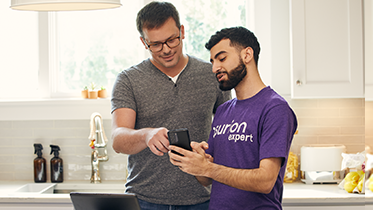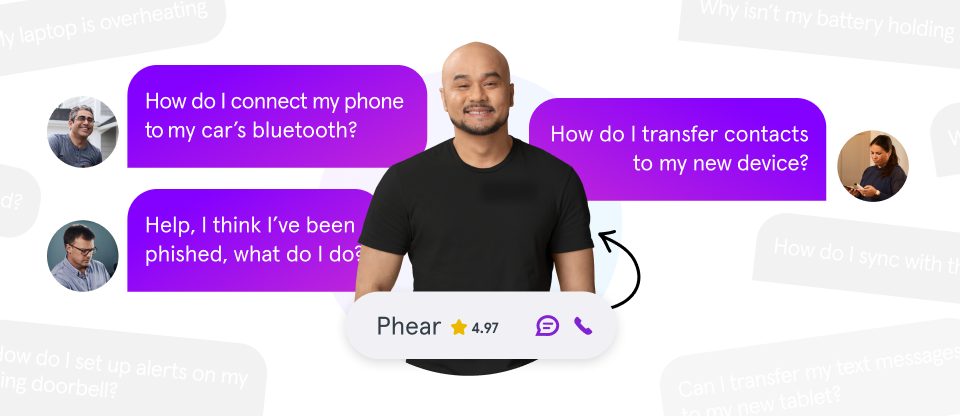What you need to know:
- An IP address is a unique number that identifies devices so they can connect and communicate over the internet.
- Knowing how to find your IP address is important for troubleshooting networks, setting up devices, or enhancing privacy.
- Find your device’s IP address by looking in the settings or by using a reputable online IP lookup tool.
- Using a VPN and enabling firewalls helps to keep your IP address secure.
Have you ever wondered how your devices communicate with each other and connect to the internet? At the heart of this process is a unique identifier called an IP address. Whether you're troubleshooting network issues, setting up a new device, or simply curious about how the internet works, understanding IP addresses is essential.
Asurion Experts have the know-how to help with all your tech care needs. In this article, we’ll explain the difference between local and public IPs and guide you through the process of finding your own IP address.
What is an IP address?
An IP address, which stands for Internet Protocol address, is a unique number assigned to each device connected to the internet. This address helps other devices find and communicate with one another, whether you're browsing a website, sending an email, or streaming a video—kind of like how a postal address lets mail reach your home.
Differences between local and public IP addresses
There are two main types of IP addresses: local (or private) and public.
- Local IP addresses. These are used within a private network, such as your home or office, to identify devices and enable communication between them. Local IP addresses are not accessible from the internet and are typically assigned by your router.
- Public IP addresses. A public IP address is assigned to your network by your Internet Service Provider (ISP) and is visible to the outside world. It's the address that other devices on the internet outside your network use to communicate with your network.
Importance of knowing your IP address
Understanding your IP address is crucial for a few reasons:
- Troubleshooting network issues. Knowing your IP address can help you diagnose and resolve connectivity problems.
- Setting up network devices. When configuring new devices, such as printers or smart home gadgets, you may need to know your IP address to establish a connection.
- Connecting with remote access. If you want to access your computer or network remotely, you'll need to know your public IP address.
- Protecting your privacy online. Being aware of your IP address can help you understand how your online activity can be traced and take steps to protect your privacy.
Now that you have a better understanding of IP addresses and how they work, let’s walk through how to find your unique IP address across different devices.

Don’t waste time scrolling
Life is short. Ask our experts and get answers now.
How to find your local IP address on Windows
Identifying your IP address on a Windows™ machine is straightforward. Below are the steps to locate your local IP address for both Windows 11 and Windows 10.
Windows 11
- Click the Start button and select Settings.
- Click Network & internet > Wi-Fi or Ethernet, depending on your connection type.
- Click the network you are connected to. Your IP address will be listed under IPv4 address.
Windows 10
- Click the Start button and select Settings.
- Click Network & Internet > Status > View your network properties.
- Your IP address will be listed next to IPv4 address.
How to find your local IP address on Mac
Every Mac® device, from your MacBook® to your iMac®, allows easy access to network settings where you can find your IP address. Simply follow these steps:
- Click the Apple menu, and select System Settings > Network.
- Select your active network connection (Wi-Fi or Ethernet).
- Click Details. Your IP address will be displayed in the list.
Where to find your local IP address on Android
Your Android™ device’s local IP address can be found in a few simple steps, depending on the manufacturer of your device:
- On a Google Pixel. Open Settings > About phone. You’ll find your IP address listed here under Device identifiers.
- On a Samsung device. Open Settings > About phone > Status information to see your IP address.
Where to find your local IP address on iPhone and iPad
Finding your IP address on an Apple device is as simple as a few taps. The process is the same on your both an iPhone and iPad:
- Open Settings > Wi-Fi.
- Tap the "i" icon next to the connected network. Your IP address will be listed here.
Determining public IP address
Your public IP address is what websites and servers see when you access them. Here are two ways to find out what your public IP address is:
- Using online IP lookup tools. A simple way to find your public IP address is by using an online IP lookup tool, like the one found on nordvpn.com. Always be sure it’s a reputable website.
- Using Command prompt. You can also find your public IP address using the Command prompt on Windows:
- Press the Windows key + R to open the Run dialog box.
- Type "cmd" and press Enter to open the Command Prompt.
- Type "nslookup myip.opendns.com resolver1.opendns.com", and press Enter. Your public IP address will then be displayed.
Risks of IP address exposure
While an IP address is crucial for internet connectivity, it can also pose potential security risks if exposed.
- Targeted attacks. Hackers can use your IP address to launch targeted attacks against your network.
- Location tracking. Your IP address can reveal your approximate geographic location, compromising your privacy.
- Online stalking. Malicious individuals may use your IP address to track your online activities and harass you.
Best practices for IP privacy
Understanding how to find and protect your IP address is essential in maintaining your privacy and security in the digital world. To maintain online privacy, consider the following best practices:
- Use a VPN. A virtual private network (VPN) encrypts your internet traffic and masks your IP address, making it difficult for others to track your online activities.
- Enable firewalls. Firewalls help prevent unauthorized access to your network by blocking suspicious incoming traffic.
- Keep software up to date. Regularly update your operating system, browsers, and other software to patch security vulnerabilities that could compromise your IP address.
- Be cautious when sharing information online. Avoid sharing personal information or clicking on suspicious links that could expose your IP address to malicious actors.
FAQs
How can I hide my IP address?
You can hide your IP address by using a VPN, which encrypts your internet traffic and replaces your real IP address with a virtual one. Other methods include using a proxy server or connecting to the Tor® network.
Can my IP address be traced?
Yes, your IP address can be traced. Websites, online services, and network administrators can see your IP address when you connect to their servers. However, the extent to which your IP address can be used to identify you personally varies depending on factors like whether you're using a static or dynamic IP address and the policies of your ISP.
What should I do if my IP address changes?
In most cases, you don't need to take any action if your IP address changes. This is common for devices using dynamic IP addresses, which are automatically assigned by your ISP and can change periodically. However, if you rely on a static IP address for certain applications or services, you may need to update your configuration settings to reflect the new IP address.





